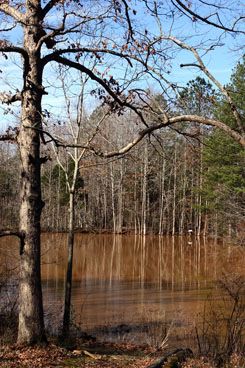|
|
|||
|
(Back to Preceding Week; on to Next Week) |
|
STUDYING SOUTHERN FLYING SQUIRRELS
Since its founding 26 years ago, Hilton Pond Center for Piedmont Natural History has placed equal emphasis on research, education, and conservation. Our activities include bird banding and nature observations (research) whose results we share through presentations, field trips, and publications (education), and we have set aside our 11 acres as a refuge for flora and fauna in the hope others will do the same (conservation). We believe there's no sense learning about nature unless we share our knowledge with students and adults, which is what we try to do on a regular basis through "This Week at Hilton Pond." The Center has always been available as a site where folks can conduct natural history research, and through the years many have taken advantage of the opportunity. Since 1982, middle and high school scholars have investigated our small mammals and studied behavior of several bird species, scientists have surveyed subsets of our plant populations, teachers and students have sampled macroinvertebrates in Hilton Pond, and--as of this week--a Ph.D. student visited the Center as part of her dissertation work on Southern Flying Squirrels.
All text & photos © Hilton Pond Center Katherine Kimball Thorington, who's working on her doctorate at Wake Forest University in Winston-Salem NC, knew about Hilton Pond because of our "This Week" postings and through her father, As planned, Katherine arrived mid-morning with her collecting gear and colleague Jackie Metheny, who's interested in bats. First, we did a walkabout on the Hilton Pond property so these two grad students would have full understanding of the habitat in which our flying squirrels live. With everything ready in the hatchback of Katherine's car, we finally swung open the side door of the bluebird box (above left) and found what were looking for: A mass of shredded bark from Eastern Red Cedar trees, the preferred nesting material for Southern Flying Squirrels across much of their range. This loosely packed bedding serves the critters well because it insulates AND its aromatic oils repel insect pests. Humans merely imitate what flying squirrels have been doing for millennia when we keep moths away from our woolens by storing them in cedar chests.
When we probed the nesting material with our finger, we could feel something warm and furry, so we knew this box contained at least one adult flying squirrel. We closed the swinging door and Katherine (above left) covered the hole in the box with a metal trap while Jackie (above right) tapped on the box to see if the flying squirrel would exit.
Nothing happened, so we re-opened the box slightly and probed the shredded cedar bark once more. Finally, a pink nose, long whiskers, and two very large black eyes appeared in the hole just before a Southern Flying Squirrel, Glaucomys volans, jumped into the trap (above).
The squirrel, which seemed a bit large for its species, explored the trap, and when it hung upside-down on the wire mesh we could see its pink teats (above)--a sure sign this was a mature female nursing offspring. This in itself was a bit surprising because Southern Flying Squirrels in the Carolinas reportedly don't breed until late January; a 40-day gestation period would mean this female must have gotten the earliest possible start to have pups by early February. (Katherine speculated our relatively warm winter may have accelerated things a bit this year.)
As Katherine quickly moved back to the car with her capture, we looked a little deeper into the nesting material in the bluebird box (above), and--sure enough--found two dark pink pups. Their eyes and ears were shut and their bodies still hairless, Back at the car Katherine successfully urged the mother squirrel from the trap into a cloth bag, which she then closed and tied shut with a cord. The bag serves several purposes: 1) It provides a semi-dark place in which the squirrel is less disturbed by the big ol' humans looking at it; 2) It allows the squirrel to be weighed (above right); and 3) It gives Katherine a way to safely grip the rodent so she can take a DNA sample. Like most small mammals, a Southern Flying Squirrel can be pretty squirmy, so it's important to securely hold the animal lest it pop out of one's hands and make for the nearest tree.
To get a better look at the pups in the nest, we gently removed one and held it in our palm for a close-up photo (below), which provided an ever better view of the pinkie's still-closed eyes and ears. We could also see a curled tail and that the pup's digits were not yet well-developed. Of particular interest was a pink squiggle running between the forearm and the hindleg; this is the skin flap that, when grown, our Southern Flying Squirrel will extend so it can glide from tree to tree.
Katherine wisely elected not to take tissue samples from the nursing squirrel pups, so we returned out little photographic subject to the nest and closed the box. After that it was relatively easy to get the mother squirrel to re-enter her nest when Katherine and Jackie held the trap against the hole in the bluebird box. We've all learned from experience that unlike many small mammals, a female flying squirrel almost never deserts her babies after being handled by humans, although she may transfer the pups to a back-up nest site she prepared in advance. After reuniting the mother squirrel with her young, we drove back to Hilton Pond's old farmhouse, which was close to a second bluebird box that we thought might contain another flying squirrel nest. When we opened this box, into the trap popped another adult squirrel--this one somewhat smaller than the first. Katherine suspected this new squirrel was also a breeding female, which we confirmed when we found two brand-new, probably day-old babies hidden in the nesting material. We quickly took the adult back to the farmhouse, where Katherine transferred it to the holding bag, weighed it, and took the tissue sample. The squirrel was back in the box in less than ten minutes. Our initial impressions of both squirrels were accurate; the first one--which looked bigger--weighed in at 79 grams and the other at 63 grams, more than half an ounce smaller. Katherine's main interest in Southern Flying Squirrels is whether the adults that often congregate together in hollow trees or other cavities in winter are related to each other, Katherine was a tad disappointed to find no flying squirrel congregations in the two occupied bluebird boxes at Hilton Pond, but the tissue samples she took may still be valuable when she or other researchers compare the DNA of populations from South Carolina with that from other parts of their range. Next year--if she's not too far along on her dissertation--we hope Katherine (and Jackie) will return in mid-winter when our Southern Flying Squirrels are still congregating. Until then, Hilton Pond Center--as always--is available as a study site for scholars, educators, and scientists who share our curiosity about plants and animals of the Carolina Piedmont.
All text & photos © Hilton Pond Center
Comments or questions about this week's installment?
Thanks to the following fine folks for recent gifts in support of Hilton Pond Center for Piedmont Natural History and/or Operation RubyThroat: The Hummingbird Project. Your tax-deductible contributions allow us to continue writing, photographing, and sharing "This Week at Hilton Pond."
"This Week at Hilton Pond" is written & photographed You may wish to consult our Index of all nature topics covered since February 2000. You can also use our on-line Hilton Pond Search Engine at the bottom of this page. For a free, non-fattening, on-line subscription to |

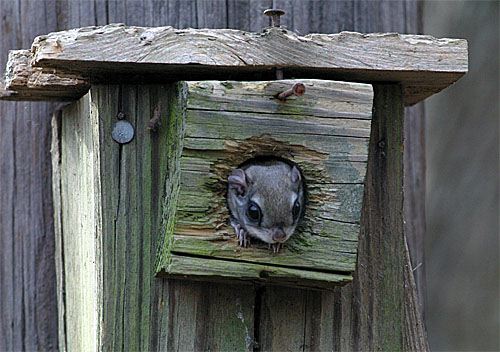
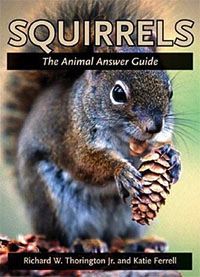 Dr. Dick Thorington Jr. of the Smithsonian Institution. Dick contacted us awhile back for information when he was working on his latest book, Squirrels: The Animal Answer Guide (right), which came out last year (2006) from Johns Hopkins University Press. It appears there's an intense and maybe innate interest in squirrels in the Thorington family, with Katherine following in her dad's footsteps and her mother contributing photos to his book. When Katherine needed DNA samples from a South Carolina breeding population of Southern Flying Squirrels, Dick advised her to contact us at Hilton Pond. We did indeed have a flying squirrel or two in the Center's bluebird nest boxes, so we arranged for Katherine to visit us on 7 March.
Dr. Dick Thorington Jr. of the Smithsonian Institution. Dick contacted us awhile back for information when he was working on his latest book, Squirrels: The Animal Answer Guide (right), which came out last year (2006) from Johns Hopkins University Press. It appears there's an intense and maybe innate interest in squirrels in the Thorington family, with Katherine following in her dad's footsteps and her mother contributing photos to his book. When Katherine needed DNA samples from a South Carolina breeding population of Southern Flying Squirrels, Dick advised her to contact us at Hilton Pond. We did indeed have a flying squirrel or two in the Center's bluebird nest boxes, so we arranged for Katherine to visit us on 7 March. The previous week we had scouted our 40-plus bluebird boxes--on and off the property--and found two were occupied by squirrel nests. One of the boxes was on a power pole on the extreme southwest corner of our 11 acres; since this locale was just off the blacktop road that forms one border of Hilton Pond Center, we decided to leave Katherine's gear in her car and drive to the nest box. Although we knew the box contained a nest, we weren't 100% sure it also had squirrels; we hadn't opened the box the preceding week just in case disturbance might make the flying squirrels desert prior to Katherine's arrival.
The previous week we had scouted our 40-plus bluebird boxes--on and off the property--and found two were occupied by squirrel nests. One of the boxes was on a power pole on the extreme southwest corner of our 11 acres; since this locale was just off the blacktop road that forms one border of Hilton Pond Center, we decided to leave Katherine's gear in her car and drive to the nest box. Although we knew the box contained a nest, we weren't 100% sure it also had squirrels; we hadn't opened the box the preceding week just in case disturbance might make the flying squirrels desert prior to Katherine's arrival.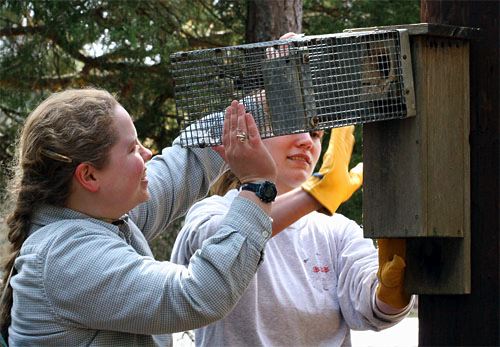
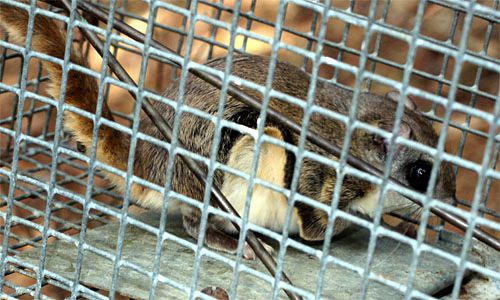

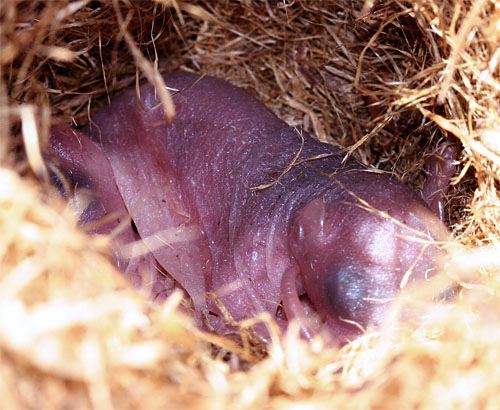
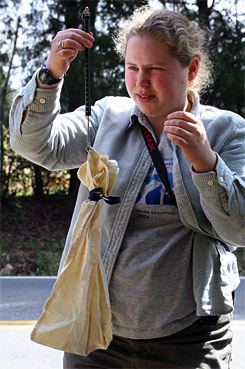 but darker pigmentation on the head and back indicted they probably were about four or five days old--possibly the first young flying squirrels of the year at Hilton Pond Center.
but darker pigmentation on the head and back indicted they probably were about four or five days old--possibly the first young flying squirrels of the year at Hilton Pond Center. With the squirrel in the bag, Katherine slowly manipulated the animal until its head was near the still-tied opening. When she was sure the squirrel's nose was at the end of the bag, she loosened the cord and allowed just the head to protrude (left). Katherine moistened a cotton ball with alcohol, wiped one of the squirrels' ears, and then used dissecting scissors to snip a very small sliver of tissue from the edge of the ear flap. The tissue sample was tiny--about the size of this apostrophe: ' --and was much smaller than the rather large chunk of ear already missing from the squirrel, probably the result of fights with other squirrels.
With the squirrel in the bag, Katherine slowly manipulated the animal until its head was near the still-tied opening. When she was sure the squirrel's nose was at the end of the bag, she loosened the cord and allowed just the head to protrude (left). Katherine moistened a cotton ball with alcohol, wiped one of the squirrels' ears, and then used dissecting scissors to snip a very small sliver of tissue from the edge of the ear flap. The tissue sample was tiny--about the size of this apostrophe: ' --and was much smaller than the rather large chunk of ear already missing from the squirrel, probably the result of fights with other squirrels. 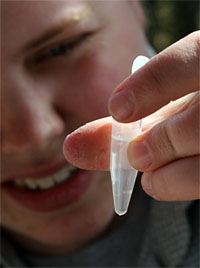 With sterilized forceps, Katherine carefully placed the ear tissue into a vial filled with 95% ethanol (right), which preserves the sample. As soon as the tissue was in the vial, Katherine transferred the squirrel from the bag to the trap, and we all returned to the bluebird nest box.
With sterilized forceps, Katherine carefully placed the ear tissue into a vial filled with 95% ethanol (right), which preserves the sample. As soon as the tissue was in the vial, Katherine transferred the squirrel from the bag to the trap, and we all returned to the bluebird nest box.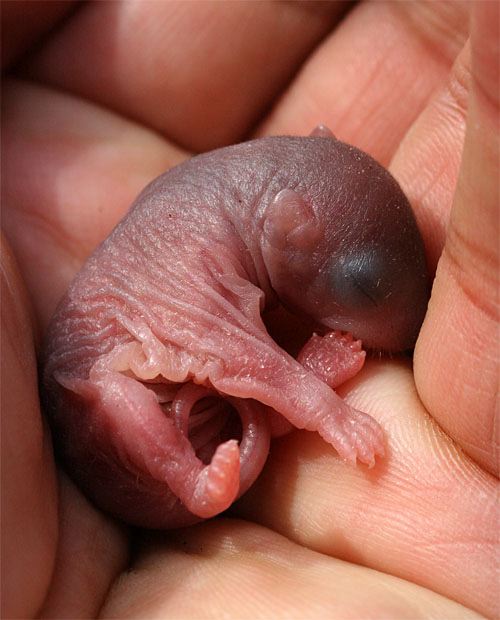
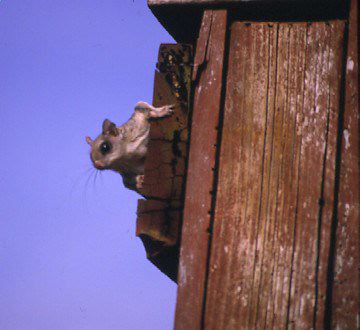 hence her taking tissue samples that will allow her to determine relatedness through DNA analysis. One might suspect that congregations of flying squirrels during non-breeding seasons would contain related animals--after all, a squirrel should be adapted to helping its offspring or siblings survive--but it may be that a flying squirrel will tolerate cold-weather cuddling with non-relatives just so it can last through the winter.
hence her taking tissue samples that will allow her to determine relatedness through DNA analysis. One might suspect that congregations of flying squirrels during non-breeding seasons would contain related animals--after all, a squirrel should be adapted to helping its offspring or siblings survive--but it may be that a flying squirrel will tolerate cold-weather cuddling with non-relatives just so it can last through the winter.

